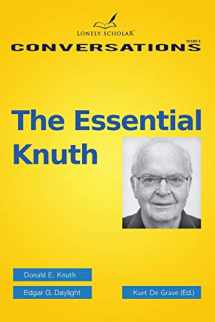
The Essential Knuth
ISBN-13:
9789491386039
ISBN-10:
9491386034
Edition:
Illustrated
Author:
Donald E. Knuth, Edgar G. Daylight, Kurt De Grave
Publication date:
2013
Publisher:
Lonely Scholar
Format:
Paperback
94 pages
Category:
Computer Science
,
Microsoft Programming
,
Programming
,
History
,
History & Culture
FREE US shipping
Book details
ISBN-13:
9789491386039
ISBN-10:
9491386034
Edition:
Illustrated
Author:
Donald E. Knuth, Edgar G. Daylight, Kurt De Grave
Publication date:
2013
Publisher:
Lonely Scholar
Format:
Paperback
94 pages
Category:
Computer Science
,
Microsoft Programming
,
Programming
,
History
,
History & Culture
Summary
The Essential Knuth (ISBN-13: 9789491386039 and ISBN-10: 9491386034), written by authors
Donald E. Knuth, Edgar G. Daylight, Kurt De Grave, was published by Lonely Scholar in 2013.
With an overall rating of 3.8 stars, it's a notable title among other
Computer Science
(Microsoft Programming, Programming, History, History & Culture) books. You can easily purchase or rent The Essential Knuth (Paperback) from BooksRun,
along with many other new and used
Computer Science
books
and textbooks.
And, if you're looking to sell your copy, our current buyback offer is $0.3.
Description
Donald E. Knuth lived two separate lives in the late 1950s. During daylight he ran down the visible and respectable lane of mathematics. During nighttime, he trod the unpaved road of computer programming and compiler writing. Both roads intersected! -- as Knuth discovered while reading Noam Chomsky's book Syntactic Structures on his honeymoon in 1961. "Chomsky's theories fascinated me, because they were mathematical yet they could also be understood with my programmer's intuition. It was very curious because otherwise, as a mathematician, I was doing integrals or maybe was learning about Fermat's number theory, but I wasn't manipulating symbols the way I did when I was writing a compiler. With Chomsky, wow, I was actually doing mathematics and computer science simultaneously." How, when, and why did mathematics and computing converge for Knuth? To what extent did logic and Turing machines appear on his radar screen? The early years of convergence ended with the advent of Structured Programming in the late 1960s. How did that affect his later work on TeX? And what did "structure" come to mean to Knuth? Shedding light on where computer science stands today by investigating Knuth's past -- that's what this booklet is about.


We would LOVE it if you could help us and other readers by reviewing the book
Book review

Congratulations! We have received your book review.
{user}
{createdAt}
by {truncated_author}


